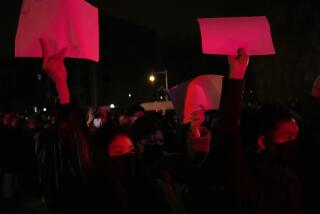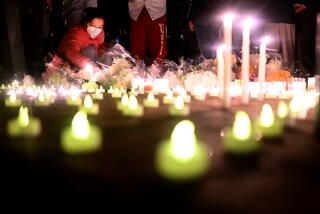Tibetan-Muslim tensions roil China
- Share via
GUOJIA, CHINA — The riot began with a customer’s complaint about her dinner.
“Waitress, there’s a tooth in my soup,” a Tibetan woman said indignantly.
Before long, a curious crowd of Tibetans gathered around the soup bowl. Restaurant owner Yun Sha came out of the kitchen and insisted that the offending item was just a chip off a lamb bone. “Let’s trash this restaurant,” Yun heard somebody scream, and the crowd proceeded to do just that.
Tables, chairs, a television flew through the air. Kitchen equipment was smashed with bricks. Soon the crowd had moved on to other Muslim restaurants on the same strip as terrified waiters and cooks scurried outside for safety.
Disputes such as that one last summer are common in western China, where a volatile ethnic stew is increasingly erupting into violence. Among China’s dozens of minorities, few get along as badly as Tibetans and Muslims. Animosities have played a major -- and largely unreported -- role in the clashes that have taken place since mid-March. During the March 14 riots in the Tibetan region’s capital, Lhasa, many of the shops and restaurants attacked were Muslim-owned. A mob tried to storm the city’s main mosque and succeeded in setting fire to the front gate. Shops and restaurants in the Muslim quarter were destroyed.
Over the last five years, there have been dozens of clashes between Tibetans and Muslims in Sichuan, Gansu and Qinghai provinces, as well as in the Tibet Autonomous Region. Most of the incidents go unreported. The state-controlled news media are not eager to publicize anything that belies Communist Party claims that minorities live together in a “harmonious society.”
Andrew M. Fischer, a London-based Tibet scholar who is one of the few who has written on the subject, said the Tibetan exile community also was reluctant to publicize incidents that might harm the international image of Tibetans.
“It is the dark side of Tibetan nationalism,” Fischer said. “It is almost as though the Tibetans are diverting their anger over their own situation towards another vulnerable minority.”
Most of the incidents involve the Hui, who ethnically are Han Chinese but practice Islam. China’s 9.8 million Hui and 5.4 million Tibetans historically have lived in proximity, at various times fighting, competing or intermarrying and collaborating.
As Buddhists, the Tibetans don’t like to kill animals, but they do eat meat and wear furs, so they leave it to Muslim butchers and tanners to do the slaughtering. The Muslims also own many restaurants, and they don’t shy away from remote Tibetan areas where other Han Chinese are loath to tread. They often buy products from Tibetan nomads, who have difficulty selling because of their illiteracy.
“To be honest, the Tibetans don’t have the business savvy of the Hui. The Tibetans have to sell their products to Hui. The Hui have to buy from the Tibetans,” said Genga Jatsi, a Tibetan doctor from Qinghai. “I suppose because we are interdependent we resent each other.”
The tensions are palpable in Golog, a mountainous prefecture in Qinghai. Along a four-lane boulevard called Tuanjie, or “Solidarity,” Street, a large archway separates the Tibetan town of Dawu from the smaller Muslim town of Guojia.
Muslim taxi drivers are nervous about crossing into the Tibetan side at night. And since last summer’s restaurant incident, Tibetans have refused to go to the strip of Muslim eateries specializing in lamb and noodles.
“We’re afraid that there will be more trouble,” said Yun, who sold his restaurant after the incident but still lives in Golog, doing construction work. He sat in an otherwise empty restaurant around the corner from his old place, he and the restaurant owner, Ma Zhongyang, slumped over the linoleum tables, watching a small television in the corner.
The men said about 800 of Guojia’s 3,000 Muslims had left in recent months, frightened by what had happened in Lhasa. During the mid-March riots, Muslim shopkeepers and their families were badly hurt and some were killed when fires set in their shops spread to upstairs apartments.
“We saw what happened on television. After that, I sent away my children from here. I fear for their safety,” Ma said.
Many Muslims have stopped wearing the traditional white caps that identify their religion. Many women now wear a hairnet instead of a scarf. Since the nearest mosque was burned down in August, the Muslims pray at home -- “in secret,” Ma said.
Twenty Tibetans, many of them monks, were arrested in the incident and a senior monk, accused of being the ringleader, was sentenced to death, Fischer said.
The animosity dates to at least the 1930s, when Muslim warlord Ma Bufeng tried to establish an Islamic enclave in Qinghai. Tibetans were pushed off their lands, some executed or forced to convert. After the communists took over in 1949, tensions were repressed.
Tsering Shayka, a Tibetan historian, said ethnic conflicts had resurfaced in recent years with the gradual liberalization of China, in particular the relaxation of travel restrictions.
“What is happening now is that you have all this transient population. People are migrating here and there and coming into more and more day-to-day contact. In the past, they weren’t allowed to trespass into each other’s territory and you had no ethnic conflict,” Shayka said.
Tibetans complain frequently about their culture being diluted when non-Tibetans, in particular Muslims, move into their areas and buy Tibetan businesses. That has been especially true in Lhasa, where Muslims now own many of the souvenir shops.
In the mid-1990s, Tibetans started boycotting Muslim restaurants in Lhasa after it was claimed that somebody had found a finger in a bowl of soup, setting off a rumor that Muslims were cannibals. Another rumor had it that Muslim cooks were urinating on food or adding their bathwater to soup, which, it was said, would function as a charm to make Tibetans convert to Islam.
“You hear all these stories about Muslims putting stuff in the soup. But I think it is all about business competition and economics,” said Tsering, 37, a Tibetan businessman from Lhasa who did not want his last name to be published.
Making matters worse, the Hui usually support the Chinese government in its repression of Tibetan separatism.
“They think the Dalai Lama is their leader. But how is independence possible?” whispers Han Rugubai, a 26-year-old Muslim who sells clothing at Dawu’s main market. “With the country developing so fast, life is good. People have enough to eat. They have clothes.”
Han said she believed that the Tibetans’ real quarrel was with the Han Chinese who dominate this country’s population and politics.
“They use us as a scapegoat for their grievances against the country,” she said.
In the last few years, clashes have broken out over the most trivial grievances. In February, a Tibetan child’s complaint about what a Hui merchant was charging for balloons triggered a brawl that involved thousands of people.
Chinese troops intervened in a 2003 dispute that started over a game of billiards. A Tibetan and a Muslim died in tit-for-tat killings, the Muslim stabbed to death with a barbecue skewer.
--
Jia Han of The Times’ Beijing Bureau contributed to this report.
More to Read
Sign up for Essential California
The most important California stories and recommendations in your inbox every morning.
You may occasionally receive promotional content from the Los Angeles Times.









